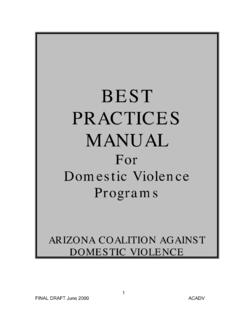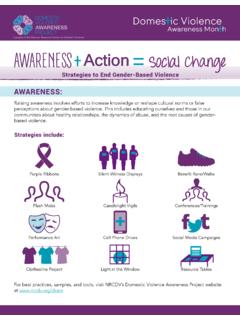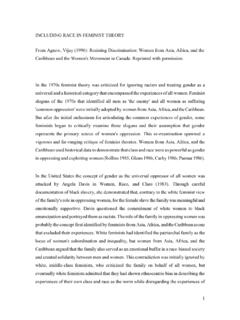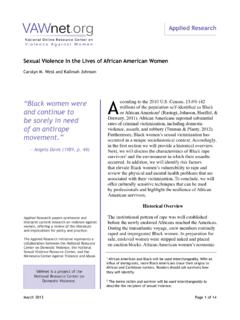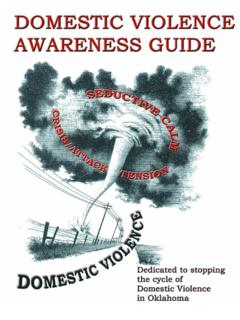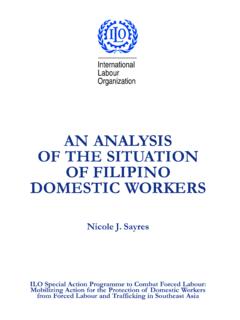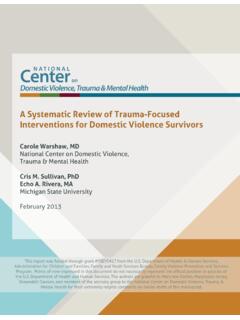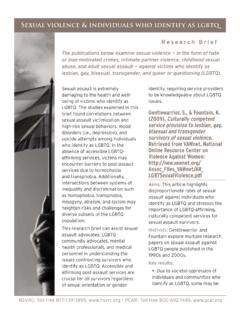Transcription of Violence Against Women and the Role of Religion
1 Violence Against Women and the Role of Religion (March 2005) Page 1 of 7*The production and dissemination of this publication was supported by Cooperative Agreement Number U1V/CCU324010-02 fromthe Centers for Disease Control and Prevention. Its contents are solely the responsibility of the authors and do not necessarilyrepresent the official views of the CDC, VAWnet, or the Pennsylvania coalition Against domestic Violence . Applied Research ForumNational Online Resource Center on Violence Against WomenBecause Religion is a personal and institutionalreality in the lives of the majority of the population inthe , it is no surprise that religious teaching andaffiliation provide a significant context for manywomen as they address experiences of texts, traditions, teachings, and doctrine,religious communities and institutions convey valuesand belief systems to their members.
2 In addition,members often have direct support or counselingrelationships with religious leaders who may provideguidance or instruction. Religious texts and teach-ings can serve as resources to assist those who haveexperienced abuse in finding safety and in theprocess of healing. Yet, Religion also can be misusedto excuse or condone abusive behavior. In thecontext of Violence Against Women , religious teach-ings and communities will play a role; they will neverbe the outset, it is important to acknowledge thetremendous diversity of beliefs, teachings, andtraditions that exist among the many religions of theworld. Within pluralistic societies such as NorthAmerica, we need to be aware of Roman Catholic,Jewish, Protestant, Orthodox Christian, Muslim,Buddhist, Hindu, Native American or First Nationsbeliefs and practices, as well as many others.
3 Inaddition, within any one particular Religion , there mayexist various denominations, movements ortraditions, with their own distinct institutions, culturesand teachings. A comprehensive exploration of therelationship between Religion and Violence againstwomen is beyond the scope of this , there are some basic issues and questions,which confront religiously identified Women whohave experienced abuse. It is our intention toaddress some of these areas of concern. Statedsimply, the reality is that regardless of the particularreligious affiliation, alongside the trauma of Violence ,a majority of Women will be dealing with someaspect of religious beliefs and teachings which willserve either as a resource or a roadblock (Fortune,1987).
4 The task for both religious and secular leader-ship is twofold: 1) to recognize that religious beliefs,texts, and teachings can serve both as roadblocksand as resources for victims of Violence and 2) todeepen our examination of religious texts andteachings and explore new interpretations so that weminimize the roadblocks and maximize the resourcesfor Women . No woman should ever be forced tochoose between safety and her religious communityor tradition. She should be able to access theresources of both community-based advocacy andshelter and faith-based support and counsel. Forher to do so, she needs these two resources to workcollaboratively so that they can provide consistentadvocacy and support for victims and survivors andparticipate in the process of holding and Reconstructing:What to do with Religious Traditions?
5 Among the many world religions, Christianity,Judaism, and Islam for example, incorporate beliefsand practices as well as cultures that vary greatly intheir impact on Women who are victims of will use these three major world religionscommon in North America to illustrate the challengesViolence Against Women and the Role of ReligionRev. Dr. Marie M. Fortune and Rabbi Cindy G. Enger VAWnet Applied Research ForumViolence Against Women and the Role of Religion (March 2005) Page 2 of 7 VAWnet: The National Online Resource Center on Violence Against Women Religion presents for victims of sexual anddomestic as Roadblock and Resource.
6 Boththe Hebrew Bible and Christian Scriptures containstory after story of Violence Against Women : (Genesis 34), Tamar (2 Samuel 13), theLevite s concubine (Judges 19), Jephthah s daughter(Judges 11), Vashti (Esther 1), Suzannah (Daniel13), and probably the persistent widow in Luke sGospel (Luke 18)2. Later Christian texts alsocondone male Violence Against Women and thedomination of Women . For example, the right ofchastisement was the enforcer of Women s subordi-nation in marriage. In the Rules of Marriage compiled by Friar Cherubino in the 15th century(Bussert, 1986) we find the careful instruction to ahusband to first reprimand his wife; And if this stilldoesn t work.
7 Take up a stick and beat hersoundly .. for it is better to punish the body andcorrect the soul than to damage the soul and sparethe body (p. 13).Unfortunately, this doctrine has been viewed asconsistent with scriptural passages interpreted toconfirm male dominance over Women : Wives besubject to your husbands as you are to the the husband is the head of the wife just as Christis the head of the church, the body of which he is theSavior. Just as the church is subject to Christ, soalso wives ought to be, in everything, to their hus-bands (Ephesians NRSV). Either by itssilence or its instruction, the church has too oftencommunicated to battered Women that they shouldstay in abusive relationships, try to be better wives,and forgive and forget.
8 To batterers, it hascommunicated that their efforts to control their wivesor girlfriends are justified because Women are to besubject to men in all things. They have been permit-ted to discipline their wives and their children allfor the good of the family. Christian history is filledwith examples of church leaders justifying abuse ofwomen by men. Church fathers like Martin Lutherunapologetically described their own physicalviolence towards their wives (Smith, 1911).In dealing with domestic Violence , however, theChristian scriptural justifications for Women remain-ing in abusive relationships (subordination in mar-riage, Ephesians 5:20; prohibition of divorce, Malachi 2:13-16) must be considered in thefuller context of ethics, theology, and (the selective use of a text, usually outof context, to support one s position) is a commonploy by those who seek to simply justify theiractions.
9 It is not difficult to prooftext a man sprerogative to dominate and control a woman withinpatriarchal western religious traditions. But itnonetheless does not represent the whole example, in Jesus ministry, he teaches: Thethief comes only to steal and kill and destroy. Icame that they may have life, and have it abun-dantly (John 10:10, NRSV). Victimization is neverGod s will but rather fullness of life. Jesus under-stood his ministry to proclaim release to the cap-tives .. (Luke 4:18 quoting Isaiah 61, NRSV).He told the story of the Good Samaritan to empha-size our responsibility to stop and care for the are fundamental teachings through whichother passages must be interpreted in as Roadblock and Resource.
10 Both thefamily and the home have been central to Jewishreligious and cultural life. Shalom bayit (peace inthe home) is an important Jewish value; it refers toan ideal state a harmonious home in which all whodwell within are nurtured and respected. Yet theconcept of shalom bayit has been misused by somewho place on Women the sole responsibility formaintaining peace in the home and even has beenused to pressure Women to remain in or return tohomes in which they have been the victims of bayit as a value and ideal to be workedtowards should not be confused with the myth ofthe perfect Jewish family, in which abuse as well asother problems have been covered up and seen assources of addition, although shalom bayit is an impor-tant Jewish value, it does not have priority overtaking action to save a life.
